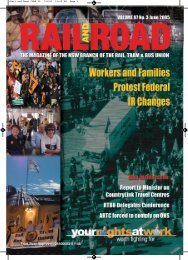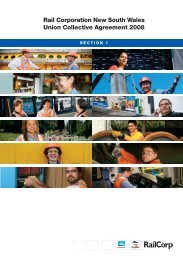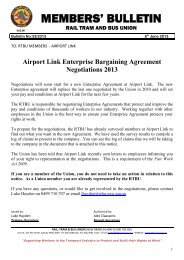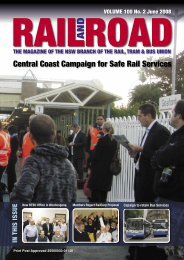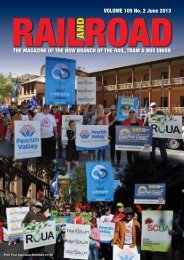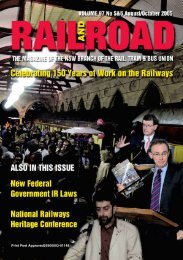Safety Matters - Rail, Tram and Bus Union of NSW
Safety Matters - Rail, Tram and Bus Union of NSW
Safety Matters - Rail, Tram and Bus Union of NSW
You also want an ePaper? Increase the reach of your titles
YUMPU automatically turns print PDFs into web optimized ePapers that Google loves.
Hazardous Substances Checklist<br />
Training <strong>and</strong> Procedures Yes NO<br />
Do you have eyewash facilities <strong>and</strong> a quick-drench shower within the<br />
work area where employees are exposed to corrosive materials?<br />
Are food <strong>and</strong> beverages consumed only in areas where there is no<br />
exposure to toxic material, blood or other potentially infectious<br />
materials?<br />
Are there appropriate procedures in place for disposing <strong>of</strong> or<br />
decontaminating personal<br />
protective equipment contaminated with or reasonable anticipated to be<br />
contaminated with blood or other potentially infectious materials?<br />
Are employees trained in the safe h<strong>and</strong>ling practices <strong>of</strong> hazardous<br />
chemicals, such as acids <strong>and</strong> caustics?<br />
Are employees aware <strong>of</strong> the potential hazards involving various<br />
chemicals stored or used in the workplace, including acids, bases,<br />
caustics, epoxies, <strong>and</strong> phenols?<br />
Is employee exposure to chemicals within acceptable levels?<br />
Are all containers, such as vats <strong>and</strong> storage tanks, labeled as to their<br />
contents?<br />
Are flammable or toxic chemicals kept in closed containers when not in<br />
use?<br />
Are chemical piping systems clearly marked as to their contents?<br />
Where corrosive liquids are frequently h<strong>and</strong>led in open containers or<br />
drawn from storage<br />
vessels or pipelines, are adequate means readily available for neutralizing<br />
or disposing <strong>of</strong> spills or overflows?<br />
Have st<strong>and</strong>ard operating procedures been established for cleaning up<br />
chemical spills?<br />
Are you familiar with the threshold limit values or permissible exposure<br />
limits <strong>of</strong> airborne contaminants <strong>and</strong> physical agents used in your<br />
workplace?<br />
Have you instituted control procedures for hazardous materials, where<br />
appropriate, such as respirators, ventilation systems, <strong>and</strong> h<strong>and</strong>ling<br />
practices?<br />
Whenever possible, are hazardous substances h<strong>and</strong>led in properly<br />
designed <strong>and</strong> exhausted booths or similar locations?<br />
Do you use general dilution or local exhaust ventilation systems to<br />
control dusts, vapors, gases, fumes, smoke, solvents, or mists that may be<br />
generated in your workplace?<br />
Is ventilation equipment provided for removal <strong>of</strong> contaminants from such<br />
operations as production grinding, buffing, spray painting, <strong>and</strong> vapor<br />
degreasing?<br />
<strong>Safety</strong> <strong>Matters</strong> A Guide for Workplace OHS Representatives<br />
SECTION FOUR<br />
RAIL<br />
TRAM AND BUS<br />
75<br />
OHS Factsheets<br />
U N<br />
I O N





